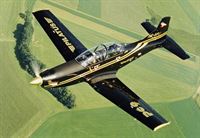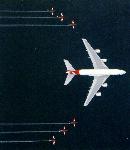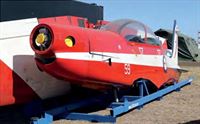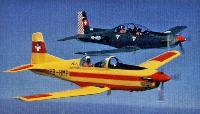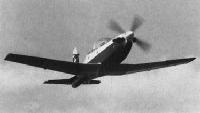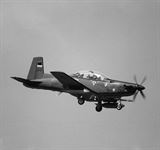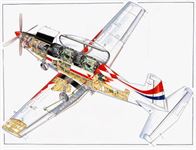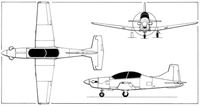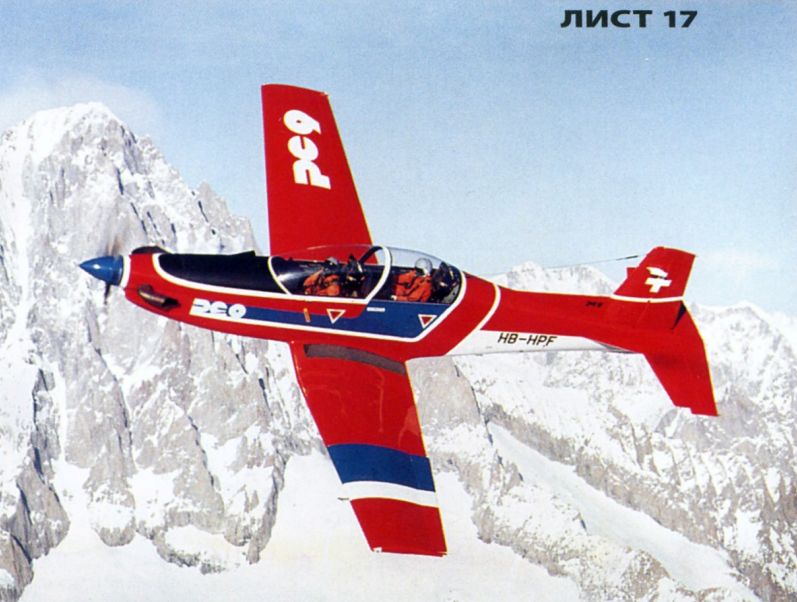
Варианты
- Pilatus - PC-9 - 1984 - Швейцария
- Beechcraft - T-6A Texan II - 1995 - США
Pilatus PC-9
Прототип учебно-тренировочного PC-9 был облетан 7 мая 1984 года, он оснащался двигателем PT6A-62. PC-9 имеет всего лишь 10% сходства в конструкции с PC-7, а его отличия включали более мощный двигатель, увеличенный фонарь пилотской кабины с тандемным размещением летчиков на катапультных креслах, подфюзеляжные воздушные тормоза и четырехлопастный воздушный винт.
Разработка нового самолета была начата в 1982 году, а испытания многих образцов оборудования и бортовых систем были проведены на летающей лаборатории - специально модифицированном PC-7 - еще до того, как постройка двух прототипов была даже начата.
PC-9 попал в "короткий" список в рамках тендера, объявленного британскими ВВС на новый УТС для замены устаревшего Jet Provost, однако победителем стал Tucano. PC-9 получил сертификат 19 сентября 1985 года, а благодаря тому, что компания "Pilatus" сохранила тесные связи с британской BAe со времени проведения тендера, вскоре ей удалось получить контракт от ВВС Саудовской Аравии на 30 самолетов. После этого "Pilatus" приняла решение сосредоточить свои маркетинговые усилия на Австралии. Компания предлагала в случае получения заказа в рамках программы австралийских ВВС "Wamira" (по приобретению нового УТС) различные офсетные сделки по PC-7 и PC-9. На этот раз победителем тендера стал PC-9, который выпускался совместно с австралийской "Hawker de Havilland" под обозначением PC-9/A.
Немецкий вариант самолета - буксировщик мишеней, получил обозначение PC-9B. Самолеты эксплуатировались компанией "Holstenair" по контракту с Люфтваффе. Другие заказчики PC-9 - Болгария, Чад, Хорватия, Ирландия, Мьянма, Словения, Швейцария и Таиланд. В 1993 году было объявлено о том, что Южная Корея приобретет 20 самолетов.
Однако поскольку корейским военным самолет требовался в варианте с возможностью подвески вооружения, то контракт вступил в противоречие со швейцарским законодательством и был подвергнут серьезному разбору.
<...>
ТАКТИКО-ТЕХНИЧЕСКИЕ ХАРАКТЕРИСТИКИ
Pilatus PC-9
Тип: УТС начальной и повышенной летной подготовки
Силовая установка: один ТВД Pratt & Whitney Canada PT6A-62 номинальной мощностью 1150 л. с. (857 кВт), пониженной до 950 л. с. (708 кВт)
Летные характеристики: максимальная скорость на уровне моря 500 км/ч; максимальная скороподъемность на уровне моря 1247 м/мин; практический потолок 11580 м; дальность полета 1642 км
Масса: пустого в базовом варианте 1685 кг; макс. взлетная 3200 кг
Размеры: размах крыла 10,12 м; длина 10,18 м; высота 3,26 м; площадь крыла 16,29 м2
- Описание
Фотографии
-
Мировая Авиация 214
Pilatus PC-9 саудовских ВВС.
-
Мировая Авиация 214
Регистрационный номер: HB-HPF [2] "Pilatus" предлагает PC-9 с различными вариантами БРЭО. Австралийские PC-9, к примеру, оснащены электронным пилотажным индикатором марки Bendix и пневматиками низкого давления.
-
Air International 1987-03 / ??? - PC-9: A Proficient Preceptor
Регистрационный номер: HB-HPF [2] The sixth series PC-9, S/N 107, is seen in demonstrator colors.
-
Air International 1985-11 / J.Fricker - Paramount Preceptor
Регистрационный номер: HB-HPB [6] The second of two Pilatus PC-9 turboprop trainers that are currently in use for flight test and development.
-
Air International 1986-03
Регистрационный номер: HB-HPB [6] -
Air International 1985-11 / J.Fricker - Paramount Preceptor
Регистрационный номер: HB-HPA [11], HB-HPB [6] The two PC-9s are seen together
-
Air International 1984-09
Регистрационный номер: HB-HPA [11] -
Jane's All the World Aircraft 2000 / 2-02 - AIRCRAFT - FIXED-WING - MILITARY/CIVIL
Регистрационный номер: HB-HPJ [3] Pilatus PC-9M Advanced Turbo Trainer demonstrator (1999)
-
Air International 1999-05 / B.Taylor - Military Aircrew Training. What's Next? /Military aviation/ (2)
Регистрационный номер: HB-HPJ [3] With its revised fin leading edge extension, just visible in this view, the Pilatus PC-9 (M) enjoys a high degree of structural commonality with the PC-7 Mk II.
-
Air International 1999-11 / Airscene
Регистрационный номер: HB-HPJ [3] The Pilatus PC-7 Mk II M and PC-9M Military Trainers are purpose-designed to comply with the high standards required in the training of future operational jet pilots. The concept includes not only high quality, outstanding reliability, unsurpassed performance and excellent handling characteristics, it also provides a comprehensive training system, integrated logistics and customer support with a full range of ground-based training equipment. With significantly reduced costs and innovative products, Pilatus leads the way in modern turboprop training.
-
Air International 1987-03 / ??? - PC-9: A Proficient Preceptor
Регистрационный номер: HB-HPC The first series PC-9 (S/N 101)
-
Air International 1985-11 / J.Fricker - Paramount Preceptor
Регистрационный номер: HB-HPA [11] Smartly finished in black and gold trim for its first flight, the first PC-9 was later repainted in colours closely approximating those of RAF training aircraft, when the Pilatus aircraft was one of the two finalists for the AST-412 requirement.
-
Aviation Historian 39 / J.Jackson - Shorts Tucano vs Pilatus PC9
Регистрационный номер: HB-HPA [11] Switzerland’s Pilatus PC-9 was a development of the same company’s PC-7. The first pre-production example (there was no prototype as such, initial testing of the modifications being completed with a PC-7) is seen here alongside a Hawk, the type for which it was competing to be the lead-in aircraft in the RAF’s training syllabus.
Другие самолёты на фотографии: Hawker-Siddeley Hawk / HS.1182 - Великобритания - 1972
-
Мировая Авиация 241
Регистрационный номер: D-FKMT Немецкая "EIS Aircraft" располагает небольшим флотом PC-9B и по контракту с Люфтваффе использует их в качестве буксировщиков мишеней. PC-9 оснащены подкрыльевыми контейнерами с лебедками Southwest RM-24 с длиной буксира 3,5 км.
-
Air International 1987-03 / ??? - PC-9: A Proficient Preceptor
The first PC-9 for the Royal Saudi Air Force (S/N108) which w»a.s handed over to the MoD on 15 December last.
-
Мировая Авиация 241
Саудовская Аравия - стартовый заказчик на PC-9, она приобрела 50 самолетов через компанию "British Aerospace". PC-9 поставлялись с 1986 года и сегодня находятся на вооружении 9-й и 22-й эскадрилий саудовских ВВС.
-
Air Pictorial 1999-10 / Pilatus: Designing for 60 years
One of 25 PC-9s delivered to No 2 FTS, Royal Thai AF, based at Kamphaeng Saen.
-
Мировая Авиация 214
Регистрационный номер: A23-020 [2] Австралия стала первой страной, строившей PC-9 по лицензии, выпустив большую часть из 67 самолетов, поставленных в национальные ВВС. На этих же самолетах выступает австралийская пилотажная группа "Roulettes".
-
Air International 2018-10 / N.Pittaway - Outback Air Combat Exercise Pitch Black /Military/
Регистрационный номер: A23-020 [2] Royal Australian Air Force forward air controllers in PC-9 aircraft operated by 4 Squadron launched from RAAF Base Tindal in support of Exercise Pitch Black 2018.
-
Air International 2019-09 / N.Pittaway - Testing times 75 years of ARDU /Military/
Регистрационный номер: A23-007 PC-9/A A23-007 over South Australia.
-
Air International 1989-01
Регистрационный номер: A23-001 -
Air International 1994-08 / M.Wright - The Royal Australian Air Force
Регистрационный номер: A23-004, A23-010, A23-012 As a replacement for the MB.326 under specification AFTS 5045 the Pilatus PC-9 was chosen to become the new follow-on trainer for the CT-4 and a total of 67 PC-9/As were delivered, commencing in October 1987. The type is flown by 2 FTS at Pearce, the CFS and the Roulettes aerobatic team, both at East Sale.
-
Мировая Авиация 241
Регистрационный номер: A23-061, A23-067 Большинство из 65 австралийских PC-9 были собраны, начиная с 1989 года, по лицензии на заводе местной компании "Hawker de Havilland". Шесть основных и один запасной PC-9 принадлежат пилотажной группе "Roulettes". Строевые PC-9 окрашены в светло-серый цвет.
-
Мировая Авиация 142
Сцена, волнующая сердца всех австралийских энтузиастов авиации, - лайнер A380 компании QANTAS в строю с пилотажной группой австралийских ВВС Roulettes.
Другие самолёты на фотографии: Airbus A380 / A3XX - International - 2005
-
Aeroplane Monthly 1997-06 / S.Commin - Skyrace '97
The RAAF aerobatic team The Roulettes opened the flying display with its four Pilatus PC-9 trainers.
-
Air International 2018-12 / News by countries
Регистрационный номер: A23-025 Mew markings for the Roulettes.
Другие самолёты на фотографии: Pilatus PC-21 - Швейцария - 2002
-
Air International 2019-09 / N.Pittaway - Testing times 75 years of ARDU /Military/
Регистрационный номер: A23-045 [3] To celebrate the 75th anniversary of the formation of the Aircraft Research and Development Unit, three aircraft with a historical link to the unit and still showcasing the unit’s tail-flash took to the skies over Nowra and the Shoalhaven coastline. The formation contained a PC-9/A aircraft currently used by the unit along with a Royal Australian Air Force F/A-18B Hornet and a Douglas Dakota, owned and maintained by the Historical Aircraft Restoration Society based at Albion Park. The ADRU plans, conducts and analyses the results of ground and flight tests of existing and new Air Force aircraft and consists of four flights located at RAAF Bases Edinburgh, Amberley, Richmond and Williamtown, staffed by qualified test pilots, flight test engineers and flight test system specialists.
Другие самолёты на фотографии: Douglas DC-3 / C-47 Skytrain/С-53 Skytrooper / Dakota - США - 1935McDonnell Douglas F/A-18B Hornet - США - 1979
-
Air International 2019-09 / N.Pittaway - Testing times 75 years of ARDU /Military/
Регистрационный номер: A23-045 [3] Другие самолёты на фотографии: Douglas DC-3 / C-47 Skytrain/С-53 Skytrooper / Dakota - США - 1935
-
Air International 2019-09 / N.Pittaway - Testing times 75 years of ARDU /Military/
Регистрационный номер: A23-045 [3] One of the Aircraft Research and Development Unit's PC-9/As, A23-045, with the 75th anniversary tail markings.
-
Air International 2019-04 / News by countries
Регистрационный номер: A23-059 Former RAAF Pilatus PC-9/A A23-059 dismantled and ready for sale at Avalon.
-
Авиация и Космонавтика 2024-05 / Некоторые знаменательные даты мая в истории авиации
Регистрационный номер: ZG969 -
Air International 1987-03 / ??? - PC-9: A Proficient Preceptor
Регистрационный номер: HB-HQA, HB-HQB [3] Two of the four PC-9s for the Union of Burma Air Force, S/N 104 in the foreground and S/N 105 in the background.
-
Мировая Авиация 241
Регистрационный номер: HB-HQB [3] В сравнении с PC-7 (на переднем плане) PC-9 имеет большие размеры и массу, а также более мощную силовую установку. Главное отличие - приподнятое заднее кресло инструктора.
Другие самолёты на фотографии: Pilatus PC-7 Turbo Trainer - Швейцария - 1966
-
Air International 2016-09 / G.Warner - Emerald Training /Military/
Irish Air Corps students’ course on the PC-9 culminates in a sortie involving navigation to a target, a land away and leading a formation to a new target within five seconds of the stipulated time.
-
Air International 2024-06 / A.Dron - Standing alone
Ireland's current fleet of eight PC-9Ms entered operational service in 2004 and is operated by the FTS at Casement Aerodrome, Baldonnel
-
Air International 2022-08 / J.Campion - Ireland's Ambitions
The Irish Air Corps’ Flight Training School operates a fleet of eight Pilatus PC-9M turboprop aircraft. One of the training modules for the school is close tactical formation flights
-
Авиация и Время 2019-06 / П.Нор - Для учебы и не только
Учебно-тренировочный самолет швейцарской компании "Пилатус" PC-9
-
Air International 2016-09 / G.Warner - Emerald Training /Military/
The PC-9’s range is 1,220km (758 miles) at a maximum cruise speed or 1,540km (956 miles) at its long-range cruise speed of 210kts (390km/h).
-
Air International 2016-09 / G.Warner - Emerald Training /Military/
Thirty hours of training are spent at between 2,000ft (609m) and 10,000ft (3,048m) over country terrain, with every second or third flight being solo.
-
Air International 2016-09 / G.Warner - Emerald Training /Military/
A PC-9 firing 2.75in Folding Fin Aerial Rockets during a training mission. The aircraft also has two 0.5in FN machine guns on underwing hardpoints.
-
Air International 2016-09 / G.Warner - Emerald Training /Military/
Flight 56 is an elementary handling test which includes circuits, forced landing, stall and spin recovery, emergency drills and aerobatics.
-
Air International 1997-01 / Airscene
Following relaxation of the UN arms embargo in the region, the Slovenian Air Force has had its three PC-9s upgraded by Pilatus at Stans with underwing hardpoints to enable carriage of armaments or underwing drop tanks. Seen here is L9-52 (formerly S5-DPT) which, along with the other two, has now gained a military serial and camouflage scheme to replace the previous high-visibility colours.
-
Air International 2016-05 / J.Kraak - Serpentex /Military/
Overview of the SERPENREX 2016 participants, including the German GFD PC-9 and the visiting Ejercito del Aire EF-18Ms.
Другие самолёты на фотографии: Dassault Mirage 2000B/N/D - Франция - 1980Dassault Rafale - Франция - 1986McDonnell Douglas F/A-18A Hornet - США - 1978
-
Air International 1997-01 / B.Walters - From the Pilatus Eyrie
Seen in company with a PC-9, this plan view of the Eagle shows its single-engine, slender fuselage and high aspect ratio wing configuration.
Другие самолёты на фотографии: Pilatus PC-12 - Швейцария - 1991
-
Air International 2022-08 / J.Campion - Ireland's Ambitions
The SCAR targeting pod is one of the developments being considered by the IAC to increase its capabilities. The pod, made by Airborne Technologies, is planned for fitting to PC-9Ms of the IAC and potentially the EC-135 helicopters. The IAC is looking to purchase three of the pods
-
Air International 1985-11 / J.Fricker - Paramount Preceptor
Регистрационный номер: HB-HPA [11] First flown at Stans on 7 May 1984, the PC-9 revealed its similarity with the PC-7, from which it was directly developed to offer increased performance and improved cockpit arrangement.
-
Air International 1985-11 / J.Fricker - Paramount Preceptor
Регистрационный номер: HB-HPA [11] View of the first PC-9, HB-HPA, show it as first flown - two days before the formal roll-out ceremony at Stans on 9 May 1984.
-
Air International 1987-03 / ??? - PC-9: A Proficient Preceptor
Регистрационный номер: HB-HQB [3] Другие самолёты на фотографии: Pilatus PC-7 Turbo Trainer - Швейцария - 1966
-
Air International 1985-11 / J.Fricker - Paramount Preceptor
Регистрационный номер: HB-HPA [11], HB-HPB [6] -
Air International 1985-11 / J.Fricker - Paramount Preceptor
Регистрационный номер: HB-HPA [11] -
Air International 1985-11 / J.Fricker - Paramount Preceptor
Регистрационный номер: HB-HPA [11] View of the first PC-9, HB-HPA, show it in the RAF-style white-and-red finish
-
Air International 1986-07 / R.Braybrook - Who Wants Fat Hair, Anyway?
"The case of the RAF’s Jet Provost replacement... illustrated a completely new and arguably healthier approach." The Pilatus PC-9 (on photo) was judged by Boscombe Down to be "totally acceptable"; the engineers were "even happier with the Tucano".
-
Air International 1985-11 / J.Fricker - Paramount Preceptor
Регистрационный номер: HB-HPB [6] -
Air International 1985-11 / J.Fricker - Paramount Preceptor
Регистрационный номер: HB-HPB [6] The second of the two pre-production PC-9s flew for the first time on 20 July 1984 and shows no external differences from the first aircraft.
-
Авиация и Космонавтика 2004-08 / В.Щербаков - Королевские военно-воздушные силы Австралии
Регистрационный номер: A23-058 УТС PC-9/A "Пилатус" (номер A23-058) из состава 2-й учебной летной школы выполняет полет в рамках исследовательской программы ARDU
-
Авиация и Космонавтика 2007-12 / М.Никольский - ВВС Хорватии
Совместный полет над Адриатикой самолетов AMX ВВС Италии и хорватского PC-9M, февраль 2005г.
Другие самолёты на фотографии: Embraer, Aermacchi AMX - International - 1984
-
Авиация и Космонавтика 2008-07 / М.Никольский - ВВС Словении
PC-9M ВВС Словении
-
Jane's All the World Aircraft 2000 / 2-02 - AIRCRAFT - FIXED-WING - MILITARY/CIVIL
One of three ex-US Army PC-9s in Slovenian service (1999)
-
Авиация и Время 2008-02 / А.Котлобовский - Эхо старой вражды (2)
Учебно-тренировочный самолет PC-9 из состава ВВС Кипра
-
Air International 1997-01 / B.Walters - From the Pilatus Eyrie
Two Eagles on the flight line at Stans, with the PC-12’s stablemates a pair of PC-9s and a PC-6 Turbo-Porter. Note that the nearest Eagle (HB-FOG) is fitted with a surveillance pod and the farthest one (HB-FOB) has winglets, but no pod.
Другие самолёты на фотографии: Pilatus PC-12 - Швейцария - 1991Pilatus PC-6 Porter / Turbo Porter - Швейцария - 1959
-
Air International 1985-11 / J.Fricker - Paramount Preceptor
Регистрационный номер: HB-HPA [11] The rear (left) and front (right) cockpits of the first pre-series Pilatus PC-9, HB-HPA, are shown here. This aircraft has the conventional electro-mechanical installation, and is also being used to flight-test the JET Electronics S-900 head-up display, which can he seen in the photograph of the front cockpit.
-
Air International 1985-11 / J.Fricker - Paramount Preceptor
The front cockpit of the second PC-9 has a Collins EFIS, displaying all flight and navigation information on the two central CRTs.
-
Мировая Авиация 241
Кабина PC-9 по типу истребителя. Для облегчения подготовки пилотов для современных типов боевых самолетов кабина PC-9 оборудована, как на современном истребителе. Приборное оборудование кабины PC-9 включает два многофункциональных индикатора электронной пилотажной информационной системы Bendix, но не имеет индикатора на лобовом стекле и приборов системы управления вооружением. Курсант и инструктор располагаются на катапультных креслах Martin-Baker Mk 11A (0 м, 111 км/ч), которые также стоят на PC-7.
-
Air International 2024-06 / A.Dron - Standing alone
A student PC-9M pilot conducts pre-flight checks with a QFI from the IAC's FTS before departing for Shannon Airport in County Clare on a training flight
-
Air International 2016-09 / G.Warner - Emerald Training /Military/
Students use the fixed training device to not only familiarise themselves with the cockpit, but also to complete some elements of their course, including 40 hours of instrument flying.
-
Air International 2016-09 / G.Warner - Emerald Training /Military/
The instructor's control panel on the FTD. An instructor can project any scenario onto a 210° viewing screen in front of a fully-working replica of a PC-9 cockpit.
-
Air International 1985-04
Другие самолёты на фотографии: Hawker-Siddeley Hawk / HS.1182 - Великобритания - 1972
-
Jane's All the World Aircraft 2000 / 2-02 - AIRCRAFT - FIXED-WING - MILITARY/CIVIL
Cutaway of the Pilatus PC-9M (1999)
-
Air Pictorial 1998-03
In profile the Pilatus PC-9 (below) has a noticeably more streamlined cockpit canopy compared with the PC-7 (above), and the nose profile and fin show further minor changes in shape.
Другие самолёты на фотографии: Pilatus PC-7 Turbo Trainer - Швейцария - 1966
-
Jane's All the World Aircraft 2000 / 2-02 - AIRCRAFT - FIXED-WING - MILITARY/CIVIL
Pilatus PC-7 Mk II M and PC-9M basic/advanced trainer (1999)
-
Air International 1999-05 / B.Taylor - Military Aircrew Training. What's Next? /Military aviation/ (2)
Three-view drawing of the Pilatus PC-7 (???), note the early-style cockpit canopy and smaller dorsal fin than the PC-7 Mk II.
-
Air International 1999-05 / B.Taylor - Military Aircrew Training. What's Next? /Military aviation/ (2)
Three-view drawing of the Pilatus PC-9, note the smaller dorsal fin than the PC-9 Mk II.
- Фотографии







